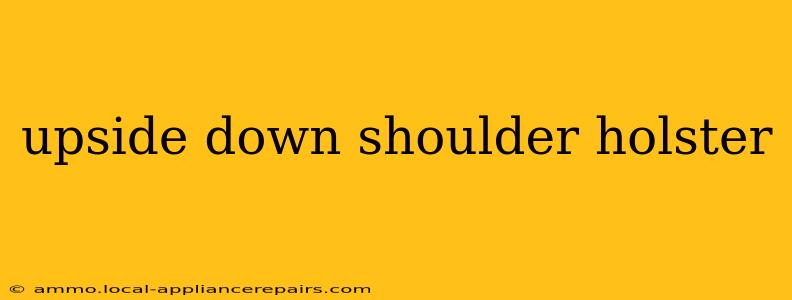The upside-down shoulder holster, a unique and often debated carry method, offers a distinct approach to concealed carry. This guide delves into the advantages, disadvantages, and considerations surrounding this specific style of holster, helping you determine if it's the right choice for you.
Understanding the Upside-Down Carry Method
Unlike traditional shoulder holsters where the firearm is carried with the barrel pointing downwards, the upside-down configuration positions the weapon with the barrel pointing upwards. This seemingly counterintuitive approach offers several benefits, but also presents significant drawbacks. Let's explore both sides of the coin.
Advantages of Upside-Down Shoulder Holsters
-
Concealment: The upside-down carry method can offer superior concealment, particularly under jackets or loose-fitting clothing. The upward orientation of the barrel often minimizes printing, making the firearm less visible. This is especially advantageous in warmer climates where heavier outerwear isn't practical.
-
Quick Draw (Arguably): Some proponents argue that the upside-down position allows for a faster draw, as the weapon is already partially oriented for a presentation. However, this is highly dependent on the individual's training and the specific holster design.
-
Reduced Printing (In Some Cases): The upward orientation can minimize the bulge of the firearm against the body, thus improving concealment in certain situations.
Disadvantages of Upside-Down Shoulder Holsters
-
Increased Risk of Accidental Discharge: This is arguably the most significant drawback. The upward orientation increases the chance of an accidental discharge if the firearm is jostled or if the safety mechanisms fail. Proper training and a high-quality, reliable holster are absolutely crucial.
-
Draw Complexity: Drawing from an upside-down shoulder holster requires a specific and practiced technique. A clumsy or rushed draw can be significantly slower and less efficient than a traditional draw. Extensive training is essential to master this method.
-
Re-holstering Challenges: Re-holstering the weapon safely and efficiently can be more complex and difficult than with a traditional shoulder holster.
-
Comfort Issues: The weight distribution can be uneven, potentially causing discomfort, especially during prolonged wear.
-
Holster Availability: Finding high-quality, well-designed upside-down shoulder holsters might be more challenging than finding traditional options.
Choosing the Right Upside-Down Shoulder Holster
If you're considering an upside-down shoulder holster, several critical factors need consideration:
-
Holster Quality: Invest in a high-quality holster made from durable, reliable materials. The holster should be designed to securely retain the firearm and prevent accidental discharges. Look for features like retention straps or a secure locking mechanism.
-
Fit and Comfort: The holster should fit your body type and firearm snugly, yet comfortably. Proper fit minimizes movement and prevents printing.
-
Material: Consider holsters made from durable materials like Kydex or leather, ensuring they can withstand regular use and maintain their integrity.
-
Accessibility and Draw: The holster should allow for a smooth, controlled draw that minimizes the chance of accidental discharge or fumbling. Practice extensively with your chosen holster and firearm.
Conclusion: Is an Upside-Down Shoulder Holster Right for You?
The upside-down shoulder holster offers unique advantages in terms of concealment, but it also presents significant risks. It's not a carry method for everyone. Thorough training, a high-quality holster, and a deep understanding of the risks involved are absolutely paramount. Before adopting this carry method, consult with experienced firearms instructors and carefully weigh the pros and cons to ensure it aligns with your skill level, experience, and individual needs. Ultimately, the decision rests on personal responsibility and preparedness. Remember, safe and responsible firearm handling is always the top priority.

